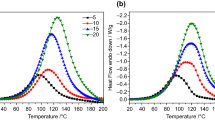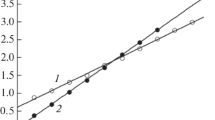Abstract
In this article, a study of the curing process of carboxyl-terminated polyester-triglycidyl isocyanurate systems is reported. A comparison is made between the generally used differential scanning calorimetric methods and rheokinetic methods, which make use of a parallel plate stress rheometer. The curing kinetics was characterized by a regression equation. The crosslinking process can be considered as a phase transformation. The phase transformation was characterized by the Avrami equation and by the scaling parameters. The glass transition temperature conversion dependence was also studied.




Similar content being viewed by others

References
Lee H, Neville K. Handbook of Epoxy-Resins. New York: McGraw Hill; 1967.
Misev A. Powder Coatings, Chemistry and Technology. Chichester: Wiley; 1991.
Schechter L, Wynstra L. Glycidyl ether reactions with alcohols, phenols, carboxylic acids and anhydrides. Ind Eng Chem. 1956;. doi:10.1021/ie50553a029.
Möhler H, Löhr R. Isocyanatvernetzender polyester mit und ohne Beschleuniger, vol. 85. Germany: Farbe and Lack; 1980. p. 165–71.
Dusek K. Network formation in curing of epoxy resins. Adv Polym Sci. 1986;. doi:10.1007/BFb003536.
Vorster OC, Halász L. The use of a rheological technique in the determination of the curing kinetics of a reactive polyester powder coating. The South African Journal of Natural Science and Technology. 2004;23:13–21.
Hsich HS-Y. Kinetic model of cure reaction and filler effect. J Appl Polym Sci. 1982;27:3265–77.
Avrami M. Kinetics of phase change: I. General theory. J Chem Phys. 1939;. doi:10.1063/1.1750380.
Avrami M. Kinetics of phase change II. Transformation–time relations for random distribution of nuclei. J Chem Phys. 1940;. doi:10.1063/1.1750631.
Stockmayer WH. Theory of molecular size distribution and gel formation in branched-chain polymers. J Chem Phys. 1943;. doi:10.1063/1.1723803.
Stockmayer WH. Theory of molecular size distribution and gel formation in branched-chain polymers. II. General crosslinking. J Chem Phys. 1943;. doi:10.163/1.1723922.
Winter HH, Chambon F. Analysis of linear viscoelasticity of a cross-linking polymer at the gel point. J Rheol. 1986;. doi:10.1122/1.549853.
Stauffer D. Gelation in concentrated critically branched polymer solutions. J Chem Soc Faraday II. 1976;. doi:10.1039/f29767201354.
Stauffer D, Coniglio A, Adam M. Gelation and critical phenomena. Adv Polym Sci. 1982;. doi:10.1007/3-540-11471-8_4.
Adolf D, Martin JE, Wilcoxon JP. Evolution of structure and viscoelasticity in an epoxy near the sol–gel transition. Macromolecules. 1990;. doi:10.1021/ma00204a028.
Martin JE, Adolf D, Wilcoxon JP. Viscoelasticity of near-critical gels. Phys Rev Lett. 1988;. doi:10.1103/PhysRevLett61.2620.
Martin JE, Adolf D, Wilcoxon JP. Viscoelasticity near the sol–gel transition. Phys Rev A. 1989;. doi:10.1103/PhysRevA.39.1325.
Winter HH, Chambon F. Analysis of linear viscoelasticity of a cross-linking polymer at the gel point. J Rheol. 1986;. doi:10.1122/1.549853.
Mours M, Winter HH. Time resolved rheometry. Rheol Acta. 1989;. doi:10.1007/BF0036658.
Mours M, Winter HH. Viscoelasticity of polymers during heating/cooling sweeps. Eng Chem Res Ind. 1995;. doi:10.1021/ie00037a006.
Izuka A, Winter HH, Hashimoto T. Molecular weight dependence of viscoelasticity of polyprolactone critical gels. Macromolecules. 1992;. doi:10.1021/ma00035a020.
Izuka A, Winter HH, Hashimoto T. Self-similar relaxation behaviour at the gel point of a blend of a crossslinking poly(ε-caprolactone) diol with a poly(styrene-coacrylonitrile). Macromolecules. 1997;. doi:10.1021/ma961620g.
Mours MM, Winter HH. Relaxation patterns of nearly critical gels. Macromolecules. 1996;. doi:10.1021/ma9517097.
Mours M, Winter HH. Relaxation patterns of nearly critical gels. Macromolecules. 1996;29:7221–8.
Martin JE, Wilcoxon JP. Critical dynamics of the sol–gel transition. Phys Rev Lett. 1988;. doi:10.1103/PhysRev.Lett61.323.
Muthukumar M. Screening effect on viscoelasticity near the gel point. Macromolercules. 1989;22:4658–64.
Vargha V, Doszlop S, Biró O. Thermal behaviour of triglycidyl-isocyanurate (TGIC) in presence and in absence of polyester. J Therml Anal. 1990;. doi:10.1007/BF01913428.
Author information
Authors and Affiliations
Corresponding author
Rights and permissions
About this article
Cite this article
Halász, L., Belina, K. An investigation into the curing of epoxy powder coating systems. J Therm Anal Calorim 119, 1971–1980 (2015). https://doi.org/10.1007/s10973-015-4411-9
Received:
Accepted:
Published:
Issue Date:
DOI: https://doi.org/10.1007/s10973-015-4411-9



